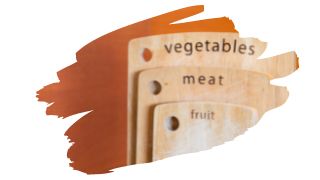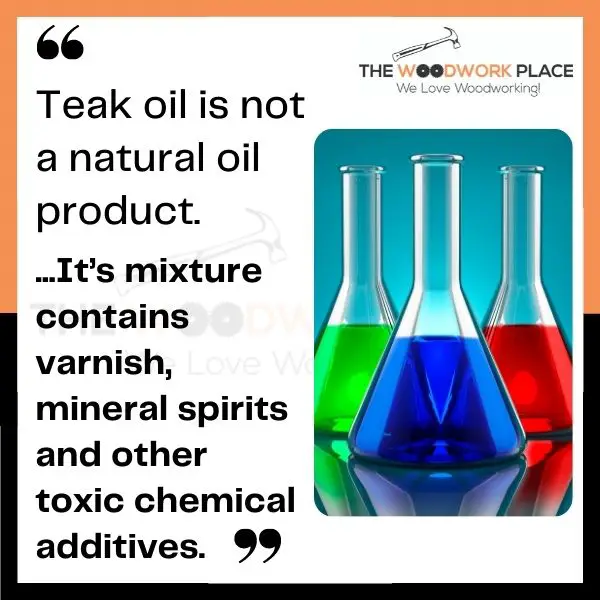Teak oil is not a natural oil. And, in its liquid form, it is a very toxic finish…one that you would not want anywhere near a food prepping surface.
This oil was originally created to protect Teak wood in the great outdoors. So, how safe can it really be to use this highly flammable oil on your cutting board?…
In this post, we dive into what really goes into that Teak oil finish (and why this oil is anything but wholly natural). You will also discover why ‘safe enough to eat off’ does not always equal ‘food-safe’. And we reveal the best non-toxic oil finish you can use on your chopping block.

This post may contain affiliate links to products that we receive a commission for (at no additional cost to you). Learn more here.
What Exactly Is Teak Oil Made Of?
If you take a look at the label of any Teak oil can, you’ll find that this finish doesn’t contain oil from the Teak tree.
Teak wood is a very dense tight-grained wood, and it produces its own natural wood preserving oil. In fact, Teak tree lumber is so naturally oily, that it can often be left untreated.
However, Teak oil doesn’t contain any actual Teak oil. Rather, this finishing product is made up of a mixed bag of natural oils, varnish, UV inhibitors, and mineral spirits.
Sometimes it may contain Linseed oil. Other times it can contain Tung oil. But, one thing Teak oil does not contain is natural Teak tree wood oil.
Related Post: Can You Apply Teak Oil On Maple Wood? (Best Practice Revealed)
Then Why Is Teak Oil Named After Teak Wood?
It’s a marketing shtick.
You see, this blended oil finish was originally designed as an oil for Teak wood…hence its ‘Teak oil’ name. But, other than its name, it bares little resemblance to real natural Teak wood oil.
Instead, Teak oil is more similar to something like Danish oil. That’s because Danish oil, (just like Teak oil), also contains Linseed/Tung oil, varnish and mineral spirits.
Basically, Teak oil is made from a hodgepodge of different ingredients – both natural and synthetic. Plus, no two Teak oil products contain the same recipe or ingredient ratios.

But, Can You Put Teak Oil On A Cutting Board?
Well, Teak oil is not at all food safe in its liquid, (or otherwise still curing), form. And even after it has dried, you still would not want to consume any hard Teak oil resin.
Still, once Teak oil has completely cured, it is safe enough to eat off of.
However, you do not want to run the risk of consuming small chips of Teak oil resin. So, that makes this oil unsuitable for something like a food prepping chopping board.
Can You At Least Use Teak Oil To Seal A Butcher Block Instead?
Even with a butcher block, you can still run the risk of chipping Teak oil resin every time you chop food. But, more than that, Teak oil isn’t a suitable finish for a food prep surface like a butcher block.
Teak oil needs less ongoing maintenance/reapplication than Mineral oil. Yet even Teak oil will still need to be recoated every 6-12 months all the same. And that recoat will happen more frequently if you wash your chopping board regularly.
That’s because, while Teak oil is water repellent, it is not water resistant. So, when you wash that butcher block, you will damage (and even remove) much of that cured teak oil coat with each rinse.
OK. So What Oils Are Food Safe Enough For A Chopping Block?
In this instance, your best choice oil finish option is Mineral oil. Why? Because mineral oil is a bit of a special finish. Especially as it’s one of only a few non-drying oils that can be reliably used on wood.
Other non-drying oils, (such as Sunflower Oil or Vegetable Oil), can go rancid. However, mineral oil will never decay or go off. That’s because this oil is made from petroleum, so this product never has an expiry date.
Now, when it comes to coating butcher blocks and cutting boards, only 100% pure food grade mineral oil should be used.
While there are many different petroleum by-products, food grade mineral oil is made from highly refined petroleum distillate. And this refined version of mineral oil is so well filtered, that it’s even safe for human consumption.
And Why Is Mineral Oil So Great At Protecting Chopping Block Wood?
Mineral oil is a non-drying oil that can soak into wood grain just like any other oil finish.
It is incredibly easy to apply, and it will coat chopping block wood fibers with it’s water-repelling oil. And this is key to preventing a wooden block from absorbing raw meat fluids and other liquids.
To Wrap Up, Here Are The 3 Key Takeaways From This Post…
1). Teak oil is not a natural oil product. It’s mixture contains varnish, mineral spirits and other toxic chemical additives.
2). Teak oil isn’t suitable for food prepping chopping blocks, because it is not a food-grade finish.
3). However, pure food grade mineral oil is a non-toxic oil finish. Which is why you should use mineral oil, (not Teak oil), on your cutting board.
References:
Welker, Christine, et al. “Bacterial retention and cleanability of plastic and wood cutting boards with commercial food service maintenance practices.” Journal of food protection 60.4 (1997): 407-413.



![A Quick Beginners Guide To Rubber Wood Vs Teak Wood [For Furniture] rubber wood vs teak wood](https://www.thewoodworkplace.com/wp-content/uploads/2022/11/Banner-523-150x150.jpg)